
|
Static Tests
Performed on the electronic test stands Fall 2005 |

|
Static Tests
Performed on the electronic test stands Fall 2005 |
| < Go to Previous Tests |
Go to 2006 Tests > |
| Excel File |
Thrust Curve |
Description |
Video |
| 9-4-05C |
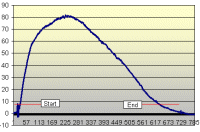
|
Loki 54mm casing with single moonburner
grain. This grain was made back in June and sealed in the case liner
with foil tape. The tape didn't hold, the grain was real gooey on the
outside. Two grains like this fired on 8/13/05, worked OK...maybe. 45g
of goo removed from this grain and reprocessed into good propellant for another
day. Propellant weight: 451g (not including Ti or smoke grain) Total thrust: 596Ns, Burn time: 2.49 seconds, ISP: 135 (probably not... I think the smoke grain burned as propellant, inflating the score. |
Video 1 meg, 7 seconds .wmv file |
| 9-5-05B |
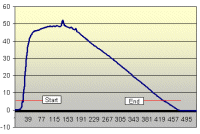
|
Dr. Rocket 38-720 casing burning
2 moonburner grains of plain rcandy. Grains aligned with aluminum-foil
duct tape, which served as their packaging. Grains were made on 5/6/05,
and thus have endured 4 months of Florida swelter. Upon opening the
package, the propellant was found to be completely dry. The "tidy package" works! Some loose Ti mill
flakes placed at head end, pointy point on curve coincides with their exit. Propellant weight: 238.7g, Total thrust: 249 Ns, Burn time: 1.7 seconds, ISP: 106 |
Video 1 meg, 7 seconds .wmv file |
| 9-10-05A |
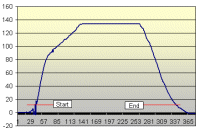
|
Loki 54mm
3-grain casing with new nozzle, 0.435 inch throat diameter, firing 3 grains
rcandy with 2.7% coarse Ti chips. Fired in Test Stand B, 500lbf load
cell, with Amp C, gain set with 47 ohm resistor. This is too much gain,
data is truncated above 133 lbf., thus thrust and ISP measurements are incorrect,
actual thrust would be similar to that of 9-11-05A. Propellant weight: 543g, Total thrust: 580 Ns, Burn time: 1.25 seconds, ISP: 109 There was dry grass hiding under the green grass. Ti fallout started several small fires around the test area. If you have fast internet access, check out Video 2, three rocket guys doing the "Ti Stomp." I'll mow before doing any further static tests with this stuff, and use the delayed Ti technique for any launch motors. |
Video 1 1 meg, 5 seconds, .wmv file Video 2 Ti Stomp 10 meg .wmv file 2min 39 sec. |
| 9-11-05A |
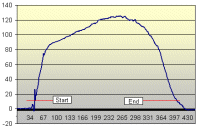
|
Loki 54mm 3-grain casing with once-used nozzle,
firing 3 grains skillet rcandy with 5 grams coarse Ti mill chips in head end
grain, making the whole load a little less than 1% Ti. This time I mowed around the test area, and fired the thing before the clippings could dry. Tested on Stand B, 500lbf load cell using INA125 amp C with gain set with 100ohm resistor. This system now reads 63.8 lbs per volt, allowing adequate headroom. Propellant weight: 542g, Total thrust: 630 Ns, Burn time: 1.48 seconds, ISP: 119 Nozzle throat erosion: 0.010 inch. |
Video 900K 10seconds, .wmv file |
| 9-18-05C (no spreadsheet) |
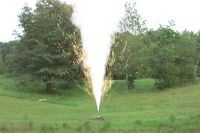
|
Loki 54mm
casing, 3 Bates grains, one of which contains 5 grams Ti mill flake. This
test is a replication of 9-11-05A, the difference being that this time the
Ti grain is at the nozzle end. This is to test the hypothesis suggested
by Mike Harris, that placing the Ti near the nozzle would lower it's velocity
when hitting the cone, thus reducing erosion. Nozzle throat erosion:
0.002 inch which is substantially less than yesterday's test, tending
to support Mike's idea. Unfortunately, there was a problem with the data cable and no test stand data was recorded. From the video I can determine that the ignition lag was 0.6 second, burn time was 1.27 second. This propellant is a bit faster-burning than that used in 9-11-05A, likely the cause of both quicker ignition and shorter burn time. |
Video 1 meg .wmv file 8 seconds |
| 9-24-05A |
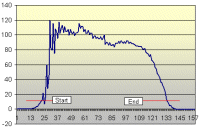
|
Dr. Rocket 38-360 casing with a single uninhibited
grain of Skillet Rcandy, made as a large (175g) batch. Added 0.5% RIO
and 1% Ti. Core is same diameter as nozzle throat. Tested on
bath scale test stand. Small wad of typing paper packed in head end,
which was expelled during the burn - this is thought to be a cause or contributor
to the spikiness of this graph. Or perhaps the CATO trauma suffered
by the stand back in July had something to do with it. Propellant weight: 153.7g Total thrust: 173 Ns, Burn time: 0.46 seconds, ISP: 115 The numbers suggest that skillet rcandy is pretty much equivalent to oven rcandy, as expected. |
Video 1 meg .wmv file, 5 seconds |
| 9-25-05B |
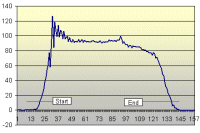
|
Dr. Rocket 38-360 casing with a single
uninhibited grain of plain Skillet Rcandy, made in two small batches of about
80g each. Core is same diameter as nozzle throat. Tested on bath
scale test stand. Four steel washers used to take up head-end space.
Still spiky, but more regular than yesterday's tests, so I am assuming
the paper wadding caused the odd bumps. Spikiness thought due to loose
and rattly scale, and/or increased sensitivity since I bumped up the gain. Propellant weight: 152g Total thrust: 174 Ns, Burn time: 0.48 seconds, ISP: 117 In this test as well, no differences were noted between skillet rcandy and oven-baked rcandy. |
Video 900K .wmv file 6 seconds |
| 11-7-05A |
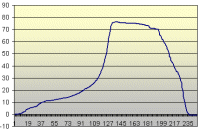 |
KN/SO/SU propellant
test in Dr. Rocket 38-360 casing. Single uninhibited grain 5
inches long. Propellant made previous evening, firm but flexible
tonight. Propellant mass: 146.4g Total thrust: 156 Ns, Burn time: 0.83 seconds, ISP: 109 Not a pretty curve. Slow ramp-up complicates analysis, could be cause of low ISP. This propellant might benefit from higher Kn ratios, a hotter ignitor, or some priming. But this mix appears to be a viable propellant, not hard to produce and rather easy to work. |